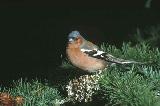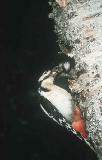|
Breckland
Santon Downham is situated in a region known as Breckland. This term, breckland, is also used to describe the habitat, being primarily sandy heathland, an important, but much-threatened habitat. One fifth of Breckland has now been covered with forest. In the 1920s, planting of confers began, to produce what we now know as Thetford Forest. This replaced the open, desolate heaths with tree cover.
|
|
 
Coniferous Forest The forest is a standing crop, and grows from seedlings to large trees which are then harvested at maturity. This means that even the plantations are ever changing. There are still parts of the forest that have been densely planted with confers, offering little to birds other than cover and limited food. Coal Tits, Chaffinches and maybe Goldcrests can be found in such areas, together with Song Thrushes, Turtle Doves and Golden Pheasant. The last example, Golden Pheasant, has declined in numbers, and is an introduced and naturalised breeding bird. Much of the tree planting has been more open, allowing limited under-storey vegetation. These areas support a wider range of birds that utilise the trees for food, cover and nest-sites. Here, as well as the species already mentioned, we may find Great Tits, Blue Tits, Wrens, Robins and some more specialised forest birds such as Crossbills, Siskins, Tawny Owls, Redstarts, Long-eared Owls and Goshawk. Mixed Forest Most blocks of trees are more than just one or two species of conifer. Planting has aimed to provide variety that is visually more pleasing as well as providing a wider range of tree species. So most areas these days have bands of deciduous trees along the edge of the pine blocks, or moderate groups in corners of the plantations. Oak has been widely used in this planting and together with silver birch, sweet chestnut and some beech, provides new sources of food and nest sites for a wider range of species of birds. Oak trees support a huge number of insects on their developing leaves and fruits, and the caterpillar crop is of great importance to many bird species. The presence of these deciduous trees encourages the presence of woodpeckers, Nuthatches, Treecreepers and summer visitors such as Willow Warblers and Chiffchaffs. Ground nesting Woodcocks are also present, but usually only seen flying at dusk. Clearings As the pine trees mature, they are cropped. At present, the forest is well into its first harvest. When the trees are removed, clearings are produced which creates a very important new, but transitional habitat. Such areas have been treated in one of several ways during forest operations, each providing a subtly different range of conditions for invading plants. Areas may be scraped clean, stumps left in situ, or piled into long ridges. Such areas are re-planted very quickly, although throughout the forest, small cleared areas have been left, specifically for wildlife. A variety of herbaceous plants soon colonises such areas providing food from seeds or associated insects. This in turn attracts a different range of birds, either foraging for food or nesting on the ground. Yellowhammers can be found in such areas, calling out their characteristic chant of "a little bit of bread and no cheeeeeese" and Skylark display and breed. Summer visiting Tree Pipits may be found around the edge of such clearings, provided there are some 'singing posts' in the form of small trees present. These new clearings have proved very important in particular for two once-declining species, Woodlarks and Nightjars, both of which move rapidly into newly cleared areas to nest on the ground among the newly planted trees. Populations of both species are now increasing in the Thetford Forest area. Other Forest Habitats Scattered throughout the forest and along the roads, tracks and railway lines are patches of other habitat, where a wider variety of shrubs and small trees such as gorse, broom, elder and hawthorn may be found. In other areas, these patches may have only very low vegetation, often together with heather (ling). This diversifies the forest habitats considerably and a wide range of birds may be found in such areas. Chaffinches, Dunnocks, Blackbirds and many others may be encountered in this patchy habitat. Even Stonechats have returned to occupy a few heath-like areas.
|
|
 
Rivers and Wet Areas The forest is bisected by the river, the Little Ouse. As well as the river itself, this produces a marked change in the nearby landscape and vegetation, all good for some bird species. The river and its banks are home to Kingfishers, often seen only as a flashing blue jewel flying past. Grey Wagtails may be found near the various bridges, Swans, Canada Geese, Coots and Moorhens feed on the river and nest on the banks. There are a few open ponds between the river and the railway line, west of the village. These and the associated wet reed and sedge areas support ducks such as Teal and other birds such as Water Rail. Alongside the river, there is a variety of wet habitats, many falling within the Forest Reserve, which flanks the river and is managed for its wildlife. Bands of poplars, marshy ground, areas of reedbed, alder trees and open water are all present. Willow Tits can be found in the aging poplars together with all three species of woodpecker, Green, Great Spotted and Lesser Spotted. There is limited understorey shrub growth in these areas, but there is usually a considerable amount of annual plants. These provide nesting cover for numerous ground nesting birds, including many summer visiting warblers such as Whitethroats and Garden Warblers. In scrubby areas, the unmistakable call of the Nightingale can be heard, while Grasshopper Warblers sound like revolving fishing reels in marshy areas. Just north of the river and west of the road bridge in Santon Downham, excessive growth of poplars and neglect of some field areas had resulted in deterioration of existing habitats. Recently, a large area has had the poplars removed and the water table raised to produce a patch of reedbed. Cattle have been put on the field area to graze down the rough grass and allow a more diverse range of plants to move in. Both of these will bring birds back to this immediate area, including Reed and Sedge Warbler and possibly breeding waders. House and Garden There are then, other easily overlooked but important habitats for birds in and around the village. The houses and their gardens provide food, shelter and nest sites for a range of species. A garden pond can provide drinking water, which will attract many birds, especially Crossbills if you are lucky. A well-stocked pond can also serve to supplement the diet of Herons (perhaps not considered so lucky by the owners!). Some of the gardens have preserved older trees, including some of the cherry trees from the Downham Estate. These will produce ripening cherry flesh for thrushes and Blackbirds, but more excitingly, the stones for Hawfinches, birds that are well-adapted to breaking into these seeds with their oversized bills. Many residents put out food to attract birds to their gardens. Santon Downham is an ideal place to do this, as the woodland on the doorstep is a huge reservoir of birds. Roving flocks will soon find food in feeders, be it mixed seed, sunflower seed or peanuts, as well as being attracted to other foods thrown out for them. This large density of garden birds in turn attracts Sparrowhawks. This species was close to extinction in the 1950s in many parts of the country as a result of the widespread use of certain pesticides. The population has largely recovered and readily passes through gardens in search of prey. The houses themselves provide several species with roost and nest sites. Each year, summer-visiting House Martins nest under the eaves of old and new properties in the village. Older houses, with access to soffit space above the eves, or older style roof tiles may have roosting and nesting Starlings taking up occupancy, or more excitingly, Swifts. Swifts are fairly site faithful, and will return year after year. As properties are modernised and tidied up, such nest sites gradually disappear.
|
|
|
|
|
|
|
|
|
|
|
|

